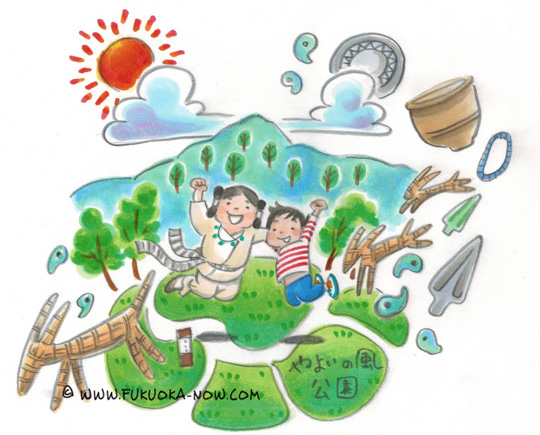Hakata Culture vol.127
Yayoi no Kaze Park: Home of the Oldest Royal Tomb in Japan

In the Yoshitake district of Nishi Ward, numerous ruins dating as far back as the Old Stone Age (20,000 years ago) have been unearthed. What are considered the most important of these ruins, dating back to the Middle Yayoi period (between 2,200 and 2,000 years ago), can be found in the Yoshitake-Takagi Site, which was named a nationally designated historic site in 1993. Part of the site was turned into the Yayoi no Kaze Park which opened this April.
Since several wooden and jar coffins were discovered on the site along with abundant burial goods, it is believed to be the final resting place for some ancient local power brokers. The discovery of bronze mirrors, bronze swords, and beads—the so-called Three Regalia—have garnered significant attention since these burial goods later came to be associated with the Imperial Family. Their existence has led the site to be considered the oldest royal tomb in Japan.
A line of big holes, each ranging from one to 1.5 meters in diameter, can be seen in one corner of the site, and these are thought to be the postholes for the pillars of a building, which could have been as large as 182 m2. If this estimate is correct, this would have been one of the largest structures of the Yayoi period. Scholars believe this suggests the existence of an ancient kingdom predating the kingdoms of Ito and Wa, which are mentioned in ancient Chinese historical records.
The new Yayoi no Kaze Park affords access to part of the historical site along with views of Mt. Iimori and the natural beauty of the western end of the city. The park features recreations of Yayoi period terrain and vegetation as well as replica jar coffins and other artifacts. One display traces the history of the site from the Old Stone Age up through the Edo period, and there are walking paths and open spaces perfect for picnicking. Meanwhile, the Three Regalia excavated from the site are on display at the Fukuoka City Museum.
最古の王墓が発見された「やよいの風公園」
西区の吉武地区では、旧石器時代(約2万年前)から江戸時代(約200年前)にいたるまで、数々の遺跡が発見されています。その中でも重要な遺跡と考えられているのが吉武高木遺跡。弥生時代中期(約2200年前~2000年前)の大規模な遺跡で、1993年に国の史跡に指定されました。一帯は「やよいの風公園」として整備が進められ、今年4月にグランドオープンしています。
吉武高木遺跡では多数の甕棺や木棺、豊富な副葬品が見つかっていることから、地域の有力者が埋葬されていると考えられています。とりわけ注目を集めたのが、揃って発見された3つの副葬品「銅鏡・銅剣・勾玉」です。代々皇室に受け継がれる宝物「三種の神器」も銅鏡・銅剣・勾玉の3種類。この3つが揃って出土した最も古い墓だったため「最古の王墓」と呼ばれています。
遺跡の一角には整然と並ぶ巨大な穴があり、これらは大型建物の柱の穴だと考えられています。直径は1~1.5メートルもあり、建物の広さは182平方メートルあったのではないかと推察されます。弥生時代としては最大級の建物です。これらのことから中国の歴史書に登場する伊都国や奴国が存在するよりも以前に、王を頂点とする国がこの地にあったのではないかと考えられています。
史跡の一部を公開するために整備された「やよいの風公園」は、飯盛山の豊かな自然を背景にのんびりした景色が広がっています。弥生時代の地形や植生を復元し、甕棺なども再現しています。旧石器時代から江戸時代までの地域の歴史を紹介するコーナーもあり、散歩やピクニックに最適です。なお、遺跡から出土した銅鏡・銅剣・勾玉は福岡市博物館に展示されています。

